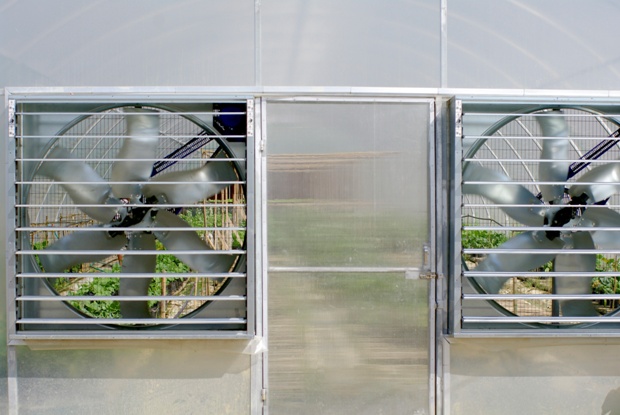Proper ventilation is one of the most important factors for success with greenhouse gardening. Fortunately, there are methods to properly ventilate a greenhouse that are not too expensive. Ventilation involves the active or passive exchange of inside air for outside air to control temperature, remove moisture and replenish carbon dioxide. In most cases it is desirable to have an active (fan driven) ventilation system rather than to rely only on convective currents to move air within and in and out of the greenhouse.
Mechanical ventilation is best achieved by having properly sized exhaust fans at one end of the greenhouse near the top and properly sized inlet louvers at the other end near mid level. This allows fresh air to enter and circulate around the plants and drives hot air out rather than allowing it to super heat the greenhouse by remaining near the ceiling. Fans can be purchased with variable speeds that are adjusted by complex thermostats, but there are other ways to achieve similar results using inexpensive variable speed fans that can be purchased at any local hardware store.

Calculating Fan and Louver Requirements
Fans come with a CFM (cubic feet per minute) rating. The first step is to calculate the cubic feet of air space inside the greenhouse. This is done by multiplying the L x W x H. As an example a 10 x 10 x 10 greenhouse would have air space of 1000 ft3. For small to medium size greenhouses, in the summer when ventilation needs are greatest, it is necessary to have the ability to exhaust the total volume of the air in the greenhouse in less than one minute. To accomplish this, a total fan capacity of 1.5 times the cubic feet of air space in the greenhouse is desirable. In this example that would be 1500 ft3. To allow for multiple combinations of air exchange it is best to divide this figure by two and get two fans with a combined capacity of the fan capacity needed. This also allows for a backup fan should one fan malfunction. It is also best to buy two-speed fans to allow for more venting options. In summer when full ventilation is needed, both fans would be set to the high setting. In winter, 35 percent of this total exhaust capacity would be appropriate and could be achieved by running only one of the fans on low. In spring and fall one fan on high may be most appropriate.
The proper size for louvers is based on the high end CFM of the exhaust fans and can be estimated by taking 2% of the CFM and making sure the louvers L + W in inches is equal to or greater than this number. In the above example 2% of 1500 is 30 so a 10×20 inch louver would be adequate.
Temperature Regulation
For temperature regulation, it is desirable to have some form of automated system. This will require fans and louvers with motors and some form of thermostatic control. Louvers need to shut and fans shut off when the temperature in the greenhouse drops below70°. Then, in the morning when the greenhouse heats up to above 78°, vents need to open and exhaust fans need to be turned back on. Fortunately, an ingenious, inexpensive alternative to traditional thermostats has been developed. These devises are called thermostatic outlets. These outlets plug into a standard electrical outlet and have an internal preset thermostat. Outlets come in two models, one for cooling and one for heating. The cooling outlet supplies power at 78° and cuts off at 70° and works great for controlling fans and louvers. The Heating outlet supplies power at 35° and cuts off at 45° and is great for automating heaters to keep greenhouse temperatures above freezing.
Proper ventilation is a must for any greenhouse, and fortunately, with a little research and planning, it can be provided without breaking the bank.
Nick Fraser is a freelance writer and greenhouse enthusiast.
Related Articles & Free Email Newsletter
5 Things to Consider Before Purchasing LED Grow Lights
Building a Seasonal Greenhouse




Comment here